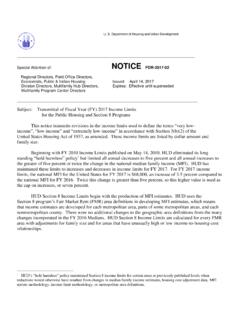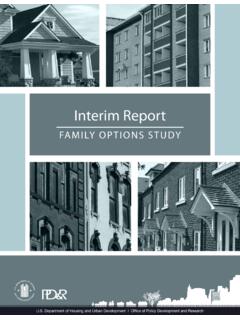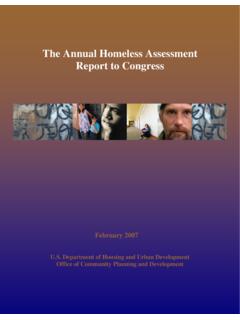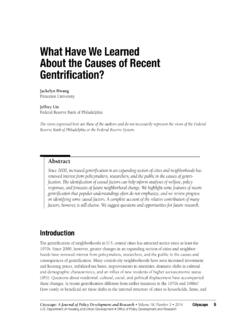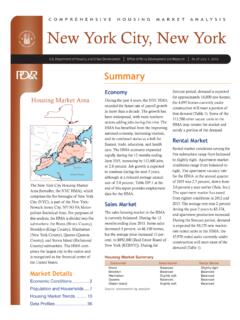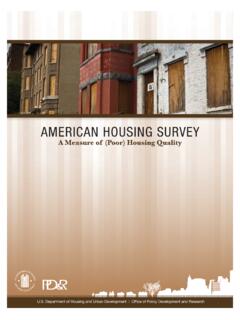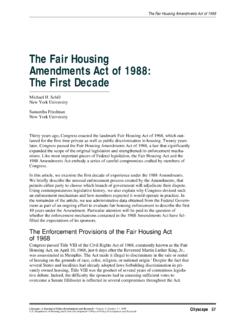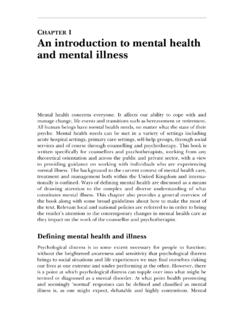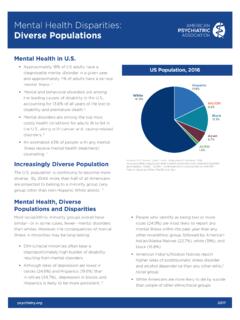Transcription of Housing First Models to Homeless Persons with Serious ...
1 T h e Ap p l i c a b i l i t y o f Ho u s i n g Fi r s t Mo d e l s t o Ho m e l e s s Pe r s o n s w i t h Se ri o u s Me n t a l Il l n e s s Department of Housing and Urban Development Office of Policy Development and Research Th e Ap p l i c a b i l i t y o f Ho u s i n g Fi r s t Mo d e l s t o Ho m e l e s s Pe r s o n s w i t h Se ri o u s Me n t a l Il l n e s s f i n a l re p o r t Prepared for: Department of Housing and Urban Development Office of Policy Development and Research Prepared by: Carol L.
2 Pearson, , Walter R. McDonald & Associates, Inc. Gretchen Locke, Abt Associates Inc. Ann Elizabeth Montgomery, Walter R. McDonald & Associates, Inc. Larry Buron, , Abt Associates Inc. Walter R. McDonald & Associates, Inc., Rockville, MD Abt Associates Inc., Cambridge, MA j u ly 2 0 0 7 ACKNOWLEDGMENTS Many individuals have assisted us on this project. We would especially like to thank the following: The formerly- Homeless men and women who agreed to participate in the study; The staff from the Department of Housing and Urban Development (HUD) and program administrators who nominated potential sites; The staff of the Housing First programs, whose time, energy, and knowledge, as well as their diligence in providing monthly data, made this study possible.
3 We would particularly like to thank our primary contacts at each of the programs: Greg Jensen and Daniel Malone Downtown Emergency Service Center (DESC), Seattle, Washington Pat Precin and Sam Tsemberis Pathways to Housing , New York City, New York Pat Bathurst, Gary Hubbard, and Roxanne Rosemire Reaching Out and Engaging to Achieve Consumer Health (REACH), San Diego, California; and Paul Dornan, our Government Technical Representative from HUD, whose commitment to this study and the report added immeasurable value.
4 Other HUD staff members who provided helpful comments throughout the study include Marge Martin, Marina Myhre, and Kevin Neary from the Office of Policy Development and Research, and Mark Johnston from the Office of Special Needs Assistance Programs. In addition, we would like to acknowledge Anja Maguire of Walter R. McDonald & Associates, Inc., who provided editorial assistance, and Jessica Bonjorni, Naomi Michlin, and Jody Schmidt Muehlegger of Abt Associates Inc., who assisted in data collection, analysis, and reporting.
5 We appreciate the significant contributions that the above individuals made to carrying out the research and writing of this report. They are not responsible for any remaining errors or omissions. The findings and views herein are those of the authors and do not necessarily reflect the views or policies of the Department of Housing and Urban Development. Foreword Understanding homelessness is a necessary step toward ending it, especially for those Persons living with a chronic condition such as mental illness , an addiction, or physical disability.
6 Ending chronic homelessness remains a national goal for President Bush, the Department of Housing and Urban Development (HUD), and many within the Homeless advocacy community. In recent years, an approach known as Housing First has emerged as one model for serving chronically Homeless people. HUD began this study as a First step in describing how Housing First programs actually work and what sorts of short term outcomes are realized by the people they serve. This report, The Applicability of Housing First Models to Homeless Persons with Serious mental illness , provides a basic description of several programs that represent a Housing First model.
7 The report should help clarify the issues and inform the policy discussion about how best to address the most vulnerable in American society. Darlene F. Williams Assistant Secretary for Policy Development and Research Preface This report presents the findings from an exploratory study of the Housing First approach of providing permanent supportive Housing to single, Homeless adults. Those served have mental illness and co-occurring substance-related disorders, and frequently come directly (or nearly directly) off the streets.
8 Congress and the Department of Housing and Urban Development (HUD) have encouraged the development of permanent supportive Housing for Homeless people since the inception of the McKinney-Vento Act in 1987. In recent years, increased public attention has been focused on the hardest-to-serve, chronically Homeless population, a substantial number of whom are mentally ill. Because it addresses this population and its needs, the Housing First approach has emerged as a favored policy response among many in the advocacy and practitioner communities.
9 Each of the three Housing First programs studied here use a low demand model to respond to substance abuse among their chronically Homeless target What is low demand? This report defines it in this way: The [low demand] approach addresses the harms caused by risk-taking behavior without forcing clients to eliminate the behavior altogether (Marlatt and Tapert, 1993). For example, abstinence is a form of [low demand] for those who want to quit using drugs, but for those who are not ready, case managers must start with interventions that can help a substance user improve his or her life.
10 Interventions might include reminding the client to eat, drink water, sleep, pay rent and other bills before spending money on drugs, and to educate users about the negative effects of drugs and encourage them to use less frequently, if not quit using entirely. One recent review of the literature indicates that the fundamental assumption of low demand is that substance use falls along a continuum from abstinence to problematic use or abuse. While abstinence and a substance-free life represent long-term goals, any immediate step in that direction, such as reducing the quantity and/or frequency of use, should be viewed positively and reinforced.
